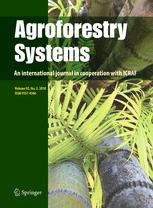View Item
- xmlui.general.dspace_homeCentros Regionales y EEAsCentro Regional Patagonia SurEEA Santa CruzArtículos científicosxmlui.ArtifactBrowser.ItemViewer.trail
- DSpace Home
- Centros Regionales y EEAs
- Centro Regional Patagonia Sur
- EEA Santa Cruz
- Artículos científicos
- View Item
A review of silvopastoral systems in native forests of Nothofagus antarctica in southern Patagonia, Argentina
Abstract
Silvopastoral systems in Nothofagus antarctica (ñire) forest have become an economical, ecological and productive alternative in Patagonia. Southern Patagonia’s experience over the past 12 years with silvopastoral systems is reviewed. The productivity and nutritive value (crude protein content and dry matter digestibility) of the understorey grassland were dependent on the interaction of environmental (mainly soil water availability and light intensity)
[ver mas...]
Silvopastoral systems in Nothofagus antarctica (ñire) forest have become an economical, ecological and productive alternative in Patagonia. Southern Patagonia’s experience over the past 12 years with silvopastoral systems is reviewed. The productivity and nutritive value (crude protein content and dry matter digestibility) of the understorey grassland were dependent on the interaction of environmental (mainly soil water availability and light intensity) and management factors under the trees and in turn determined animal performance. A method developed for carrying capacity estimation at the paddock level was based on the potential aboveground net primary production, and values ranged from 85 to 2200 kg DM ha−1 year−1. Planned thinning in secondary forest stands provides wood production and also improves the undestorey DM production by increasing incoming radiation. Within a management plan, a stand’s water stress conditions as well as the use of Reineke’s stand density index are proposed to assist in determining thinning intensities. Livestock production is the main annual income of silvopastoral systems where cattle and mixed livestock production (cattle + sheep) is the main activity. Animal performance at the whole farm scale is presented by comparing traditional extensive grazing management with an adaptive silvopastoral management that included strategic separation in homogeneous areas (grass steppe, forest and riparian meadows), stocking rate adjustment to grassland net primary production and the protection of regeneration from herbivores browsing. Data from litter decomposition, nutrient cycling and carbon storage studies also are presented. Finally, aspects related to the criteria and indicators to assess ñire forest’s sustainability under silvopastoral use along with biodiversity conservation issues are presented.
[Cerrar]

Author
Peri, Pablo Luis;
Bahamonde, Héctor Alejandro;
Lencinas, María Vanessa;
Gargaglione, Veronica Beatriz;
Soler Esteban, Rosina Matilde;
Ormaechea, Sebastián Gabriel;
Martínez Pastur, Guillermo José;
Fuente
Agroforestry systems 90 (6) : 933–960. (December 2016)
Date
2016-12
ISSN
0167-4366
1572-9680
1572-9680
Formato
pdf
Tipo de documento
artículo
Palabras Claves
Derechos de acceso
Restringido
 Excepto donde se diga explicitamente, este item se publica bajo la siguiente descripción: Creative Commons Attribution-NonCommercial-ShareAlike 2.5 Unported (CC BY-NC-SA 2.5)
Excepto donde se diga explicitamente, este item se publica bajo la siguiente descripción: Creative Commons Attribution-NonCommercial-ShareAlike 2.5 Unported (CC BY-NC-SA 2.5)

